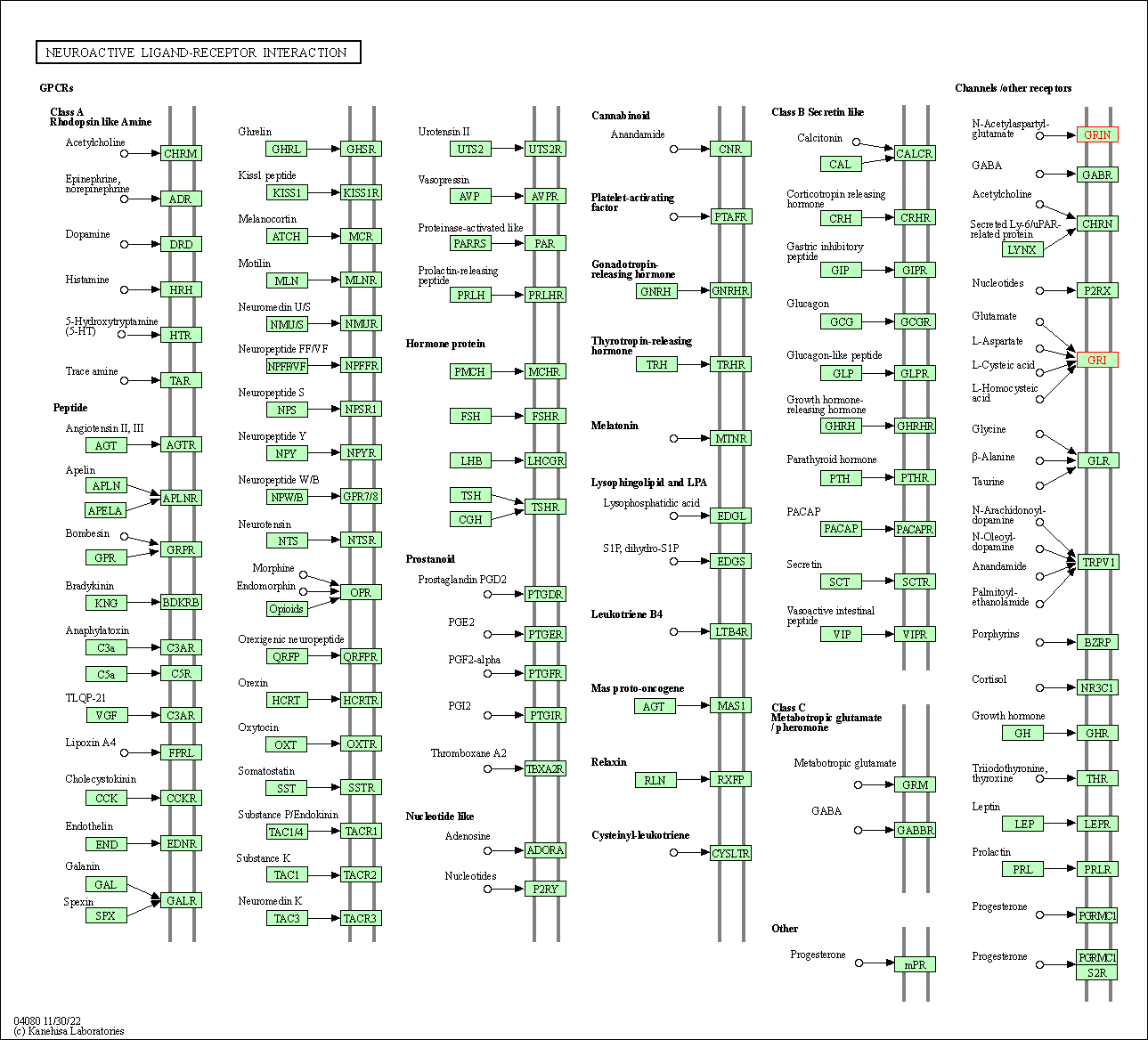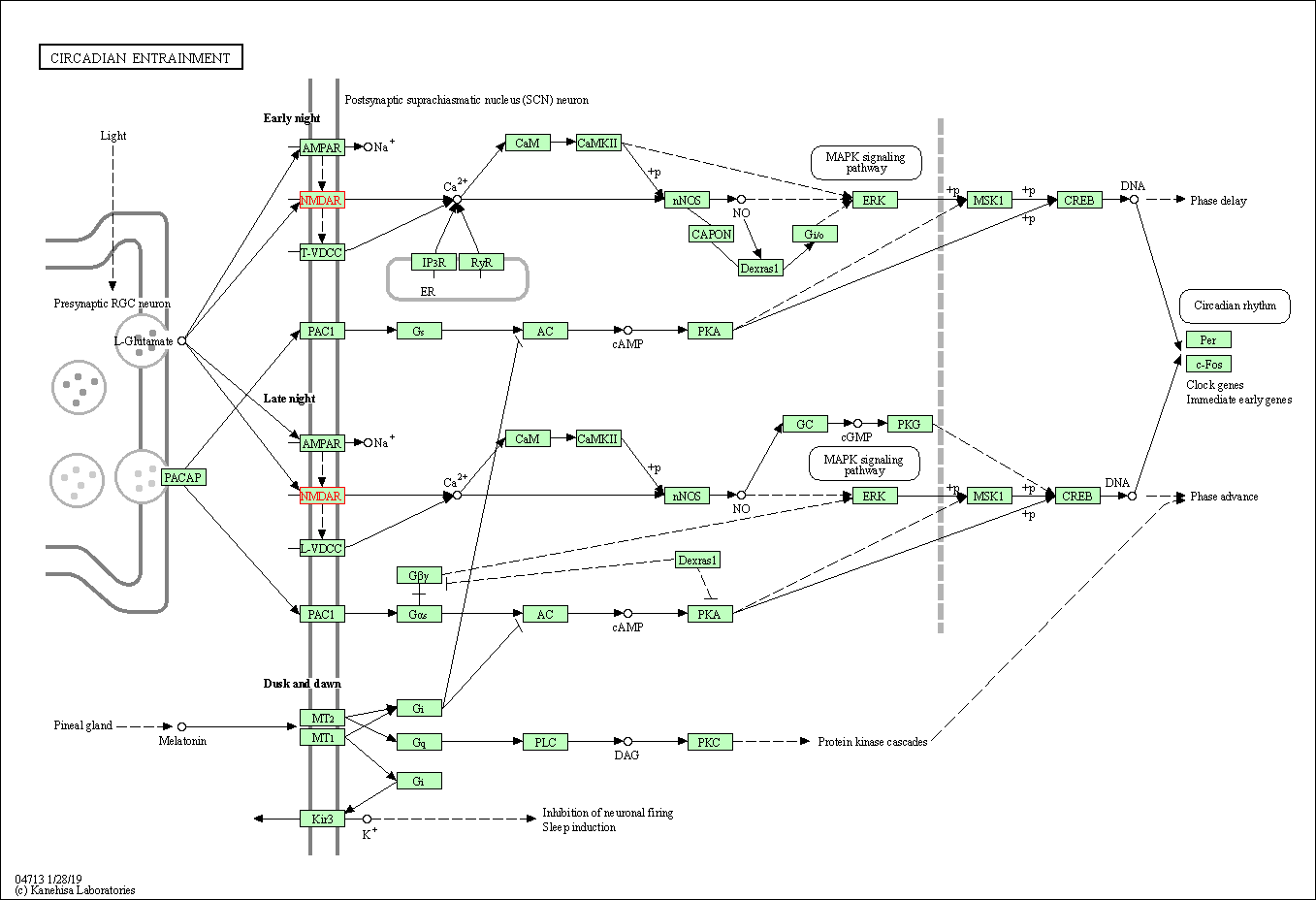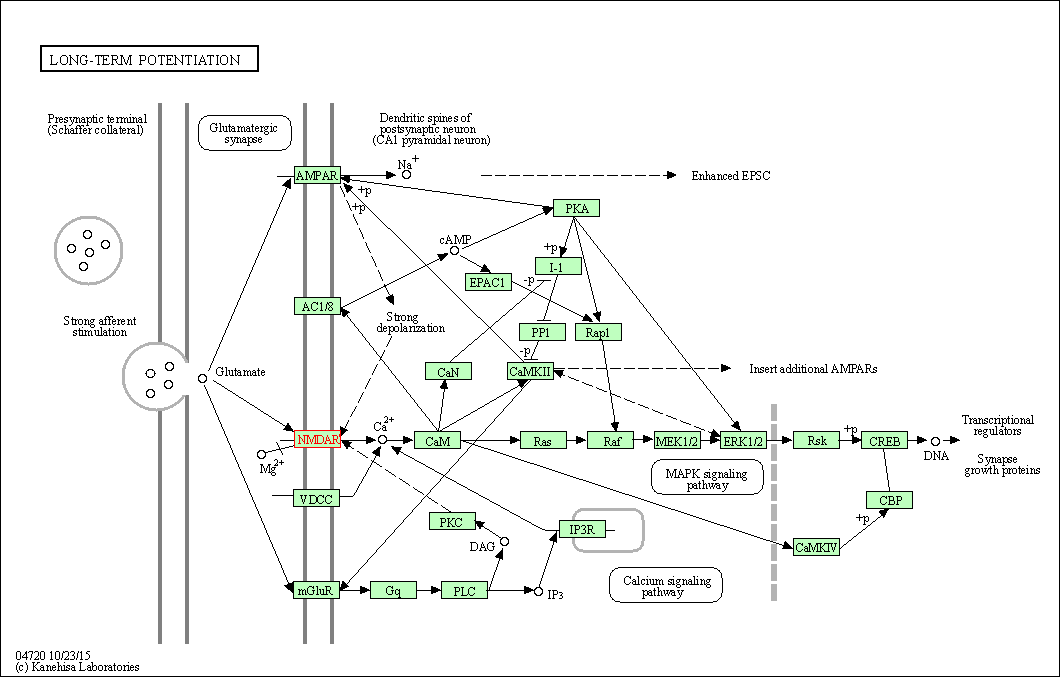Target Information
| Target General Information | Top | |||||
|---|---|---|---|---|---|---|
| Target ID |
T56588
(Former ID: TTDI03225)
|
|||||
| Target Name |
Glutamate receptor ionotropic NMDA 2D (GluN2D)
|
|||||
| Synonyms |
NR2D; NMDAR2D; N-methyl D-aspartate receptor subtype 2D; Glutamate receptor ionotropic, NMDA 2D; Glutamate [NMDA] receptor subunit epsilon-4; GluN2D; EB11
Click to Show/Hide
|
|||||
| Gene Name |
GRIN2D
|
|||||
| Target Type |
Literature-reported target
|
[1] | ||||
| Disease | [+] 1 Target-related Diseases | + | ||||
| 1 | Neurodegenerative disorder [ICD-11: 8A20-8A23] | |||||
| Function |
Component of NMDA receptor complexes that function as heterotetrameric, ligand-gated ion channels with high calcium permeability and voltage-dependent sensitivity to magnesium. Channel activation requires binding of the neurotransmitter glutamate to the epsilon subunit, glycine binding to the zeta subunit, plus membrane depolarization to eliminate channel inhibition by Mg(2+). Sensitivity to glutamate and channel kinetics depend on the subunit composition.
Click to Show/Hide
|
|||||
| UniProt ID | ||||||
| Sequence |
MRGAGGPRGPRGPAKMLLLLALACASPFPEEAPGPGGAGGPGGGLGGARPLNVALVFSGP
AYAAEAARLGPAVAAAVRSPGLDVRPVALVLNGSDPRSLVLQLCDLLSGLRVHGVVFEDD SRAPAVAPILDFLSAQTSLPIVAVHGGAALVLTPKEKGSTFLQLGSSTEQQLQVIFEVLE EYDWTSFVAVTTRAPGHRAFLSYIEVLTDGSLVGWEHRGALTLDPGAGEAVLSAQLRSVS AQIRLLFCAREEAEPVFRAAEEAGLTGSGYVWFMVGPQLAGGGGSGAPGEPPLLPGGAPL PAGLFAVRSAGWRDDLARRVAAGVAVVARGAQALLRDYGFLPELGHDCRAQNRTHRGESL HRYFMNITWDNRDYSFNEDGFLVNPSLVVISLTRDRTWEVVGSWEQQTLRLKYPLWSRYG RFLQPVDDTQHLTVATLEERPFVIVEPADPISGTCIRDSVPCRSQLNRTHSPPPDAPRPE KRCCKGFCIDILKRLAHTIGFSYDLYLVTNGKHGKKIDGVWNGMIGEVFYQRADMAIGSL TINEERSEIVDFSVPFVETGISVMVARSNGTVSPSAFLEPYSPAVWVMMFVMCLTVVAVT VFIFEYLSPVGYNRSLATGKRPGGSTFTIGKSIWLLWALVFNNSVPVENPRGTTSKIMVL VWAFFAVIFLASYTANLAAFMIQEEYVDTVSGLSDRKFQRPQEQYPPLKFGTVPNGSTEK NIRSNYPDMHSYMVRYNQPRVEEALTQLKAGKLDAFIYDAAVLNYMARKDEGCKLVTIGS GKVFATTGYGIALHKGSRWKRPIDLALLQFLGDDEIEMLERLWLSGICHNDKIEVMSSKL DIDNMAGVFYMLLVAMGLSLLVFAWEHLVYWRLRHCLGPTHRMDFLLAFSRGMYSCCSAE AAPPPAKPPPPPQPLPSPAYPAPRPAPGPAPFVPRERASVDRWRRTKGAGPPGGAGLADG FHRYYGPIEPQGLGLGLGEARAAPRGAAGRPLSPPAAQPPQKPPPSYFAIVRDKEPAEPP AGAFPGFPSPPAPPAAAATAVGPPLCRLAFEDESPPAPARWPRSDPESQPLLGPGAGGAG GTGGAGGGAPAAPPPCRAAPPPCPYLDLEPSPSDSEDSESLGGASLGGLEPWWFADFPYP YAERLGPPPGRYWSVDKLGGWRAGSWDYLPPRSGPAAWHCRHCASLELLPPPRHLSCSHD GLDGGWWAPPPPPWAAGPLPRRRARCGCPRSHPHRPRASHRTPAAAAPHHHRHRRAAGGW DLPPPAPTSRSLEDLSSCPRAAPARRLTGPSRHARRCPHAAHWGPPLPTASHRRHRGGDL GTRRGSAHFSSLESEV Click to Show/Hide
|
|||||
| 3D Structure | Click to Show 3D Structure of This Target | AlphaFold | ||||
| HIT2.0 ID | T92XYL | |||||
| Drugs and Modes of Action | Top | |||||
|---|---|---|---|---|---|---|
| Discontinued Drug(s) | [+] 1 Discontinued Drugs | + | ||||
| 1 | L-689560 | Drug Info | Terminated | Neurodegenerative disorder | [2], [3] | |
| Mode of Action | [+] 4 Modes of Action | + | ||||
| Antagonist | [+] 10 Antagonist drugs | + | ||||
| 1 | L-689560 | Drug Info | [1] | |||
| 2 | CGP61594 | Drug Info | [1] | |||
| 3 | d-AP5 | Drug Info | [1] | |||
| 4 | d-CCPene | Drug Info | [1] | |||
| 5 | LY233053 | Drug Info | [1] | |||
| 6 | UBP141 | Drug Info | [5] | |||
| 7 | [3H]CGP39653 | Drug Info | [1] | |||
| 8 | [3H]CGS19755 | Drug Info | [1] | |||
| 9 | [3H]CPP | Drug Info | [1] | |||
| 10 | [3H]MDL105519 | Drug Info | [1] | |||
| Agonist | [+] 5 Agonist drugs | + | ||||
| 1 | (RS)-(tetrazol-5-yl)glycine | Drug Info | [1] | |||
| 2 | 2-Methylamino-succinic acid(NMDA) | Drug Info | [1] | |||
| 3 | D-aspartic acid | Drug Info | [1] | |||
| 4 | homoquinolinic acid | Drug Info | [1] | |||
| 5 | L-aspartic acid | Drug Info | [1] | |||
| Modulator (allosteric modulator) | [+] 1 Modulator (allosteric modulator) drugs | + | ||||
| 1 | DQP-1105 | Drug Info | [4] | |||
| Blocker (channel blocker) | [+] 2 Blocker (channel blocker) drugs | + | ||||
| 1 | N1-dansyl-spermine | Drug Info | [1] | |||
| 2 | [3H]dizocilpine | Drug Info | [1] | |||
| Cell-based Target Expression Variations | Top | |||||
|---|---|---|---|---|---|---|
| Cell-based Target Expression Variations | ||||||
| Different Human System Profiles of Target | Top |
|---|---|
|
Human Similarity Proteins
of target is determined by comparing the sequence similarity of all human proteins with the target based on BLAST. The similarity proteins for a target are defined as the proteins with E-value < 0.005 and outside the protein families of the target.
A target that has fewer human similarity proteins outside its family is commonly regarded to possess a greater capacity to avoid undesired interactions and thus increase the possibility of finding successful drugs
(Brief Bioinform, 21: 649-662, 2020).
Human Tissue Distribution
of target is determined from a proteomics study that quantified more than 12,000 genes across 32 normal human tissues. Tissue Specificity (TS) score was used to define the enrichment of target across tissues.
The distribution of targets among different tissues or organs need to be taken into consideration when assessing the target druggability, as it is generally accepted that the wider the target distribution, the greater the concern over potential adverse effects
(Nat Rev Drug Discov, 20: 64-81, 2021).
Human Pathway Affiliation
of target is determined by the life-essential pathways provided on KEGG database. The target-affiliated pathways were defined based on the following two criteria (a) the pathways of the studied target should be life-essential for both healthy individuals and patients, and (b) the studied target should occupy an upstream position in the pathways and therefore had the ability to regulate biological function.
Targets involved in a fewer pathways have greater likelihood to be successfully developed, while those associated with more human pathways increase the chance of undesirable interferences with other human processes
(Pharmacol Rev, 58: 259-279, 2006).
Biological Network Descriptors
of target is determined based on a human protein-protein interactions (PPI) network consisting of 9,309 proteins and 52,713 PPIs, which were with a high confidence score of ≥ 0.95 collected from STRING database.
The network properties of targets based on protein-protein interactions (PPIs) have been widely adopted for the assessment of target’s druggability. Proteins with high node degree tend to have a high impact on network function through multiple interactions, while proteins with high betweenness centrality are regarded to be central for communication in interaction networks and regulate the flow of signaling information
(Front Pharmacol, 9, 1245, 2018;
Curr Opin Struct Biol. 44:134-142, 2017).
Human Similarity Proteins
Human Tissue Distribution
Human Pathway Affiliation
Biological Network Descriptors
|
|
| Protein Name | Pfam ID | Percentage of Identity (%) | E value |
|---|---|---|---|
| Protein piccolo (PCLO) | 26.923 (56/208) | 3.65E-05 |
|
Note:
If a protein has TS (tissue specficity) scores at least in one tissue >= 2.5, this protein is called tissue-enriched (including tissue-enriched-but-not-specific and tissue-specific). In the plots, the vertical lines are at thresholds 2.5 and 4.
|
| KEGG Pathway | Pathway ID | Affiliated Target | Pathway Map |
|---|---|---|---|
| Calcium signaling pathway | hsa04020 | Affiliated Target |

|
| Class: Environmental Information Processing => Signal transduction | Pathway Hierarchy | ||
| cAMP signaling pathway | hsa04024 | Affiliated Target |

|
| Class: Environmental Information Processing => Signal transduction | Pathway Hierarchy | ||
| Neuroactive ligand-receptor interaction | hsa04080 | Affiliated Target |

|
| Class: Environmental Information Processing => Signaling molecules and interaction | Pathway Hierarchy | ||
| Circadian entrainment | hsa04713 | Affiliated Target |

|
| Class: Organismal Systems => Environmental adaptation | Pathway Hierarchy | ||
| Long-term potentiation | hsa04720 | Affiliated Target |

|
| Class: Organismal Systems => Nervous system | Pathway Hierarchy | ||
| Glutamatergic synapse | hsa04724 | Affiliated Target |

|
| Class: Organismal Systems => Nervous system | Pathway Hierarchy | ||
| Click to Show/Hide the Information of Affiliated Human Pathways | |||
| Degree | 2 | Degree centrality | 2.15E-04 | Betweenness centrality | 0.00E+00 |
|---|---|---|---|---|---|
| Closeness centrality | 1.99E-01 | Radiality | 1.34E+01 | Clustering coefficient | 1.00E+00 |
| Neighborhood connectivity | 3.90E+01 | Topological coefficient | 5.57E-01 | Eccentricity | 13 |
| Download | Click to Download the Full PPI Network of This Target | ||||
| Chemical Structure based Activity Landscape of Target | Top |
|---|---|
| Drug Property Profile of Target | Top | |
|---|---|---|
| (1) Molecular Weight (mw) based Drug Clustering | (2) Octanol/Water Partition Coefficient (xlogp) based Drug Clustering | |
|
|
||
| (3) Hydrogen Bond Donor Count (hbonddonor) based Drug Clustering | (4) Hydrogen Bond Acceptor Count (hbondacc) based Drug Clustering | |
|
|
||
| (5) Rotatable Bond Count (rotbonds) based Drug Clustering | (6) Topological Polar Surface Area (polararea) based Drug Clustering | |
|
|
||
| "RO5" indicates the cutoff set by lipinski's rule of five; "D123AB" colored in GREEN denotes the no violation of any cutoff in lipinski's rule of five; "D123AB" colored in PURPLE refers to the violation of only one cutoff in lipinski's rule of five; "D123AB" colored in BLACK represents the violation of more than one cutoffs in lipinski's rule of five | ||
| References | Top | |||||
|---|---|---|---|---|---|---|
| REF 1 | URL: http://www.guidetopharmacology.org Nucleic Acids Res. 2015 Oct 12. pii: gkv1037. The IUPHAR/BPS Guide to PHARMACOLOGY in 2016: towards curated quantitative interactions between 1300 protein targets and 6000 ligands. (Target id: 459). | |||||
| REF 2 | URL: http://www.guidetopharmacology.org Nucleic Acids Res. 2015 Oct 12. pii: gkv1037. The IUPHAR/BPS Guide to PHARMACOLOGY in 2016: towards curated quantitative interactions between 1300 protein targets and 6000 ligands. (Ligand id: 4239). | |||||
| REF 3 | Trusted, scientifically sound profiles of drug programs, clinical trials, safety reports, and company deals, written by scientists. Springer. 2015. Adis Insight (drug id 800001828) | |||||
| REF 4 | Mechanism for noncompetitive inhibition by novel GluN2C/D N-methyl-D-aspartate receptor subunit-selective modulators. Mol Pharmacol. 2011 Nov;80(5):782-95. | |||||
| REF 5 | Synthesis and pharmacology of N1-substituted piperazine-2,3-dicarboxylic acid derivatives acting as NMDA receptor antagonists. J Med Chem. 2005 Apr 7;48(7):2627-37. | |||||
If You Find Any Error in Data or Bug in Web Service, Please Kindly Report It to Dr. Zhou and Dr. Zhang.

